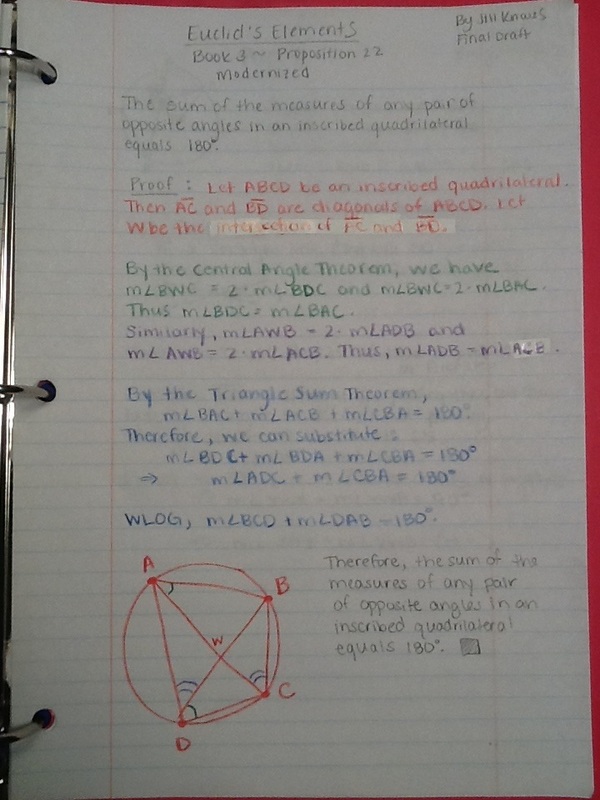It has been a couple of years since I taught geometry, and I only taught it for one year at that. Needless to say, my geometry skills are a little rusty. As a result, taking Modern Geometry (MTH 641) at Grand Valley State University this semester is proving to be a challenge, but in a way that I feel is helping me to become a better teacher. My professor has allowed the focus of the course to be on the teaching of geometry rather than purely geometry content, as all of the students are currently teaching mathematics at some level. This has given me the opportunity to analyze my approach and get down to the foundational building blocks of this fascinating branch of mathematics.
Over the past couple of weeks, we have been looking in detail at Euclid’s Elements. Reading the propositions in the mathematical language of Euclid’s day has challenged me to think about the true meaning of each statement. I cannot rely on my intuition or tidbits I memorized long ago. Rather, I feel it has placed me on an even playing field with my students. I actually feel as though I am learning it for the first time. One of our assignments this week was to take one of Euclid’s propositions from Book 3 (circles) and “modernize” it. I chose Propositions 22: The sum of opposite angles of quadrilaterals in circles equals two right angles. My version reads as follows: The sum of the measures of any pair of opposite angles in an inscribed quadrilateral equals 180 degrees. When I scrutinized the proof, one of Euclid’s methods of reasoning was easily recognizable to me. His proof said, “in any triangle the sum of the three angles equals two right angles.” Clearly two right angles is the same as 180 degrees, which indicates that he is referring to the modern-day Triangle Sum Theorem. His next justification was more of a puzzler. He claimed that two angles CAB and BDC were congruent because they were “in the same segment BADC.” This took some digging. When I looked back at Proposition 21, I found that this claim was in reference to the fact that a central angle subtended by two points is equal to twice the inscribed angle subtended by the same two points (paraphrased). By comparing two different inscribed angles subtended by the same two points, their measures were inferred to be the same. This, I finally realized, was an application of the Central Angle Theorem. From there I was able to finish my proof with ease. (See below.)
This assignment proved to be a great exercise! It took me out of my comfort zone and required genuine thinking and learning to take place. I have a renewed respect for historical mathematical texts, and I will look for a ways to have my high school students examine a piece or two sometime this year. It will also fit in great with the math department’s goal at my school to incorporate content literacy into the curriculum.
Professor Golden: I would love to hear some feedback from you with regards to some historical texts that might be the appropriate level for high school students, or even an idea for how to incorporate historical reading into an assignment or project. Thanks!
Over the past couple of weeks, we have been looking in detail at Euclid’s Elements. Reading the propositions in the mathematical language of Euclid’s day has challenged me to think about the true meaning of each statement. I cannot rely on my intuition or tidbits I memorized long ago. Rather, I feel it has placed me on an even playing field with my students. I actually feel as though I am learning it for the first time. One of our assignments this week was to take one of Euclid’s propositions from Book 3 (circles) and “modernize” it. I chose Propositions 22: The sum of opposite angles of quadrilaterals in circles equals two right angles. My version reads as follows: The sum of the measures of any pair of opposite angles in an inscribed quadrilateral equals 180 degrees. When I scrutinized the proof, one of Euclid’s methods of reasoning was easily recognizable to me. His proof said, “in any triangle the sum of the three angles equals two right angles.” Clearly two right angles is the same as 180 degrees, which indicates that he is referring to the modern-day Triangle Sum Theorem. His next justification was more of a puzzler. He claimed that two angles CAB and BDC were congruent because they were “in the same segment BADC.” This took some digging. When I looked back at Proposition 21, I found that this claim was in reference to the fact that a central angle subtended by two points is equal to twice the inscribed angle subtended by the same two points (paraphrased). By comparing two different inscribed angles subtended by the same two points, their measures were inferred to be the same. This, I finally realized, was an application of the Central Angle Theorem. From there I was able to finish my proof with ease. (See below.)
This assignment proved to be a great exercise! It took me out of my comfort zone and required genuine thinking and learning to take place. I have a renewed respect for historical mathematical texts, and I will look for a ways to have my high school students examine a piece or two sometime this year. It will also fit in great with the math department’s goal at my school to incorporate content literacy into the curriculum.
Professor Golden: I would love to hear some feedback from you with regards to some historical texts that might be the appropriate level for high school students, or even an idea for how to incorporate historical reading into an assignment or project. Thanks!

 RSS Feed
RSS Feed